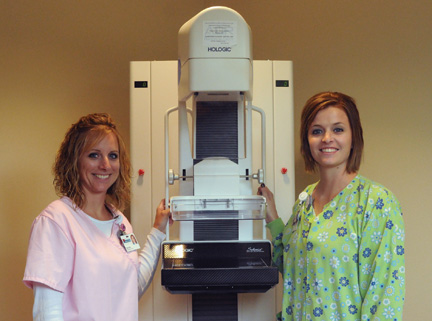Radiology Team Celebrates Breast Cancer Awareness Month
The radiology team of Thayer Central Health Services is made up of Audra Hergott, the director of radiology, and Amy Gregory and Shelly Pulliam, the two radiologists with certificates in mammography.
“I like having the one-on-one time with the patient,” said Pulliam. “Being in a small area, we know a lot of our patients. Its nice to have that connection with them and it puts them at ease as well.”
“They feel comfortable with us because its small town,” said Gregory. “We do mammograms for teachers and family friends.”
According to the mammographers, they do about 675 to 680 mammograms a year. This averages to between 30 and 50 a month.
Women should typically start scheduling mammograms at age 40; however, if a woman has a family history of breast cancer, she should begin earlier.
If something is found on a woman under 30, the technicians use an ultrasound.
Men can get mammograms as well but usually only if they have a lump or their doctors feel there is something there.
For a standard screening, the patients change into a gown and take four pictures, two on each side. The process usually only takes ten to 15 minutes.
The machine uses compression to separate the breast tissue, which is very dense.
If a lump is found, the technicians have it stat read within 30 to 40 minutes and the patient will have to have additional views.
“We do different pictures from what we did the first time and from there they usually order an ultrasound or a biopsy,” said Gregory. “When they do a biopsy, they send it in to pathology where they find out whether it is cancerous.”
It is important that women schedule an annual mammogram because “every year your breast tissue changes, especially as you get older,” said Pulliam.
“You don’t always have symptoms when it comes to having breast cancer,” said Gregory. “A lot of people come in and don’t have problems. Not everybody has a lump.”
By keeping track of yearly mammograms, radiologists can compare different years’ mammograms and see how breast tissue has changed. If they locate something that wasn’t there in the past, they know it needs to be checked out further.
“Getting people in the door to get the mammogram done is a big step,” said Gregory. “It’s one a lot of people don’t take.”
But the challenge doesn’t end there: getting people to return is another obstacle.
“A lot of people have had horrible experiences with mammograms and they don’t want to come back,” said Pulliam.
However, when patients are convinced to come in, the radiologists said many of the women don’t find the experience to be as nearly as bad as they thought it would.
“They say ‘this is much better than the last one I had; I don’t know what I was so worried about,’” said Pulliam.
The radiologists pointed out that it takes a certain type of person to perform mammograms.
“You can’t be rough around the edges,” said Gregory. “You have to be talkative and compassionate.”
The two technicians try to initiate conversations with the patients to help them relax. Two popular topics are Husker football and the holidays.
They try to make their schedules flexible so patients can come in first thing in the morning, over lunch break or after work.
The hospital will be having an employee pink out day on Oct. 23 where staff decorate their offices in pink and try to dress up in as much pink as they can. Throughout the month of October they will have other fun activities and selling pink t-shirts. The proceeds will go to Susan G. Komen for the Cure.
“We try to make it fun,” said Gregory. “It’s a way to encourage people and remind them that its important.”
Events like breast cancer awareness month are important because they are unifying.
“I think it’s a way to make everyone aware that there’s lots of people who have suffered or been lost to breast cancer,” said Pulliam. “It’s something that we can promote: take care of yourself so that we can catch something soon enough. It could be treatable.”


